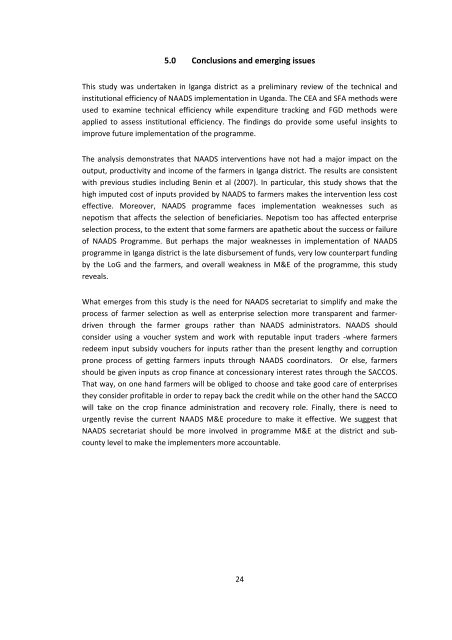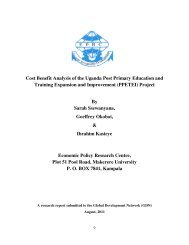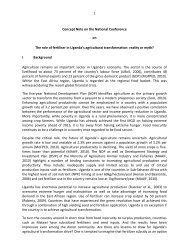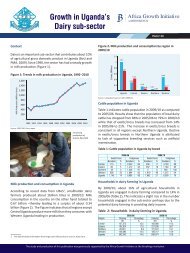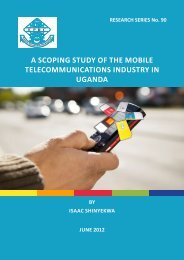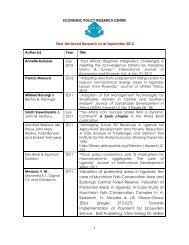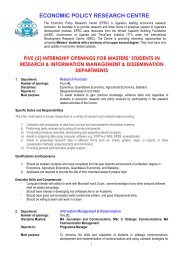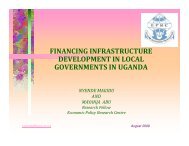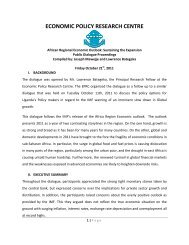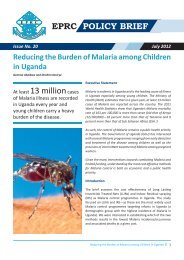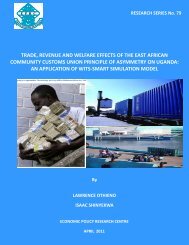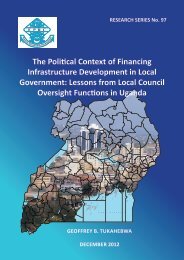the case of iganga district - Economic Policy Research Centre
the case of iganga district - Economic Policy Research Centre
the case of iganga district - Economic Policy Research Centre
- No tags were found...
Create successful ePaper yourself
Turn your PDF publications into a flip-book with our unique Google optimized e-Paper software.
5.0 Conclusions and emerging issuesThis study was undertaken in Iganga <strong>district</strong> as a preliminary review <strong>of</strong> <strong>the</strong> technical andinstitutional efficiency <strong>of</strong> NAADS implementation in Uganda. The CEA and SFA methods wereused to examine technical efficiency while expenditure tracking and FGD methods wereapplied to assess institutional efficiency. The findings do provide some useful insights toimprove future implementation <strong>of</strong> <strong>the</strong> programme.The analysis demonstrates that NAADS interventions have not had a major impact on <strong>the</strong>output, productivity and income <strong>of</strong> <strong>the</strong> farmers in Iganga <strong>district</strong>. The results are consistentwith previous studies including Benin et al (2007). In particular, this study shows that <strong>the</strong>high imputed cost <strong>of</strong> inputs provided by NAADS to farmers makes <strong>the</strong> intervention less costeffective. Moreover, NAADS programme faces implementation weaknesses such asnepotism that affects <strong>the</strong> selection <strong>of</strong> beneficiaries. Nepotism too has affected enterpriseselection process, to <strong>the</strong> extent that some farmers are apa<strong>the</strong>tic about <strong>the</strong> success or failure<strong>of</strong> NAADS Programme. But perhaps <strong>the</strong> major weaknesses in implementation <strong>of</strong> NAADSprogramme in Iganga <strong>district</strong> is <strong>the</strong> late disbursement <strong>of</strong> funds, very low counterpart fundingby <strong>the</strong> LoG and <strong>the</strong> farmers, and overall weakness in M&E <strong>of</strong> <strong>the</strong> programme, this studyreveals.What emerges from this study is <strong>the</strong> need for NAADS secretariat to simplify and make <strong>the</strong>process <strong>of</strong> farmer selection as well as enterprise selection more transparent and farmerdriventhrough <strong>the</strong> farmer groups ra<strong>the</strong>r than NAADS administrators. NAADS shouldconsider using a voucher system and work with reputable input traders ‐where farmersredeem input subsidy vouchers for inputs ra<strong>the</strong>r than <strong>the</strong> present lengthy and corruptionprone process <strong>of</strong> getting farmers inputs through NAADS coordinators. Or else, farmersshould be given inputs as crop finance at concessionary interest rates through <strong>the</strong> SACCOS.That way, on one hand farmers will be obliged to choose and take good care <strong>of</strong> enterprises<strong>the</strong>y consider pr<strong>of</strong>itable in order to repay back <strong>the</strong> credit while on <strong>the</strong> o<strong>the</strong>r hand <strong>the</strong> SACCOwill take on <strong>the</strong> crop finance administration and recovery role. Finally, <strong>the</strong>re is need tourgently revise <strong>the</strong> current NAADS M&E procedure to make it effective. We suggest thatNAADS secretariat should be more involved in programme M&E at <strong>the</strong> <strong>district</strong> and subcountylevel to make <strong>the</strong> implementers more accountable.24


